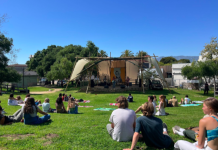Arturo Samaniego
National Beat Reporter
A new report from the Council of Graduate Schools found a decline in international graduate applications and enrollment for the first time in a decade. The CGS stated in their report that applications from international graduate students declined by 3 percent and first time enrollment of international graduate students declined by 1 percent.
The report looked at the admission cycles for fall 2016 and fall 2017. CGS International Graduate Admission Survey gathered the data in the report. The survey tracked applications and enrollment of international students seeking U.S. master’s and doctoral degrees.
The survey collected data from eight countries of origins for international graduate students that included Brazil, Canada, China, India, Mexico, Saudi Arabia, Republic of Korea (South Korea), and Taiwan. Additionally, data was collected from seven regions of the world that included Asia, the Middle East, and North Africa, and Latin America to name a few.
The survey asked 709 U.S. colleges and universities to report the final number of applications and offers of admission to international graduate students. The survey also asked them to report first-time and total international graduate enrollment for fall 2017.
“Last year we saw a slight dip (less than 2 percent) in the number of international students who applied to our graduate students, but we saw a large increase (almost 33 percent) in the number of international students who enrolled,” said UCSB Linguistics Professor Carol Genetti and Dean of the Graduate Division, in a comment to The Bottom Line.
Genetti attributed this growth to UCSB’s increased financial support for international students which she claimed has made UCSB more competitive in recruiting students.
According to the Office of International Students and Scholar website, the cost of attendance including tuition, fees, and living expenses for the 2016-17 academic year for international graduate students was $50,230.
The growth Genetti reported also falls in line with reports from last year that showed “roughly one percent increase per year, in international student enrollment” at UCSB, while there was a decline in the number of international student applicants to the University of California.
The CGS report contributed the overall decline to over a four percent decrease in applications and a 2.8 percent decrease in first-time enrollment, in master’s and certificate programs. There was a 1.8 percent increase in first-time, international doctoral enrollment despite the overall decline.
Another notable trend the report cited was that the “2016-2017 admissions cycle marks the second year in a row that applications and first-time enrollment of international graduate students from the Middle East and North Africa declined.”
Applications from Iran and Saudi Arabia, who send the largest share of international graduate students from the Middle East and North Africa, declined by 18 percent and 21 percent respectively.
The report noted recent changes in immigration policy as a point of concern for the graduate education community, with worries that these changes tarnish the “U.S.’s image as a welcoming destination for international students and scholars.”
Genetti stated that she does not know how changes in U.S. immigration policies such as Executive Order 13769, “the travel ban,” might have affected applications of international graduate students to UCSB. However, Genetti stated that “there were a handful of students from the countries specified in the Executive Order that did not enroll this fall due to the change in policy.”
Cierra Raine Sorin, the vice president of communications and records for the Graduate Student Association, hesitated to accept claims that changes in U.S. immigration policy contributed to the decline. Sorin said that “our recent restrictions on immigration are already negatively affecting graduate students across the U.S.”
“I know of at least one student who cannot return to their home country until they finish their degree as they will not be allowed back into the U.S. once they step across the border, per Trump’s new ban,” said Sorin, a Ph.D student in sociology.
Both Genetti and Sorin expressed that international students are essential to UCSB’s graduate programs. Genetti claimed they provide a diversity of talents, perspectives, and cultural enrichment to the graduate community. Without embracing these students, she believes that UCSB cannot call itself a world-class research university.
Despite the reported declines in applications and enrollment, the CGS noted in a press release that the application rates and admission yields are comparable to last year. This suggests that international students still remain highly likely to accept offers of admission to U.S. graduate schools.
When it comes to attracting more international graduate students to U.S. universities, Sorin stated that ideally universities can do more to address financial difficulties that international students face under the current tax law and work restrictions per visas.
Genetti stated that more international graduate students would be attracted to U.S. universities by spreading the word about stellar research opportunities and other benefits, like distinguished faculty, that come with graduate programs in the U.S.










